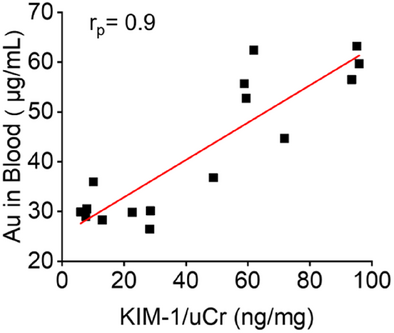Blood Retention and Kidney Clearance of Renal-Clearable Gold Nanoparticles Strongly Correlate with Renal Injury Biomarkers
Graphical Abstract
In a doxorubicin-induced acute kidney injury model, proximal tubular injury—rather than glomerular leakage—predominantly determines the renal clearance of gold nanoclusters. The blood retention of Au₂₅(SG)₁₈ strongly correlates with proximal tubular injury biomarker KIM-1, highlighting its potential as a sensitive exogenous blood marker for proximal tubular injury.
Abstract
Renal-clearable engineered nanoparticles are typically filtered through the glomeruli and transported along the renal tubules before entering the bladder. However, the effects of glomerular leakage and tubular injury, two common features of kidney diseases, on nanoparticle transport remain poorly understood. Herein, we investigated the blood retention, kidney accumulation, and renal clearance of Au₂₅(SG)₁₈ in a doxorubicin-induced acute kidney injury (AKI) mouse model. By correlating its transport with proteinuria and urinary kidney injury molecule-1 (KIM-1), endogenous biomarkers of glomerular leakage and proximal tubular injury, respectively, we found that glomerular leakage, as indicated by a >50-fold increase in proteinuria, did not enhance its blood clearance. Instead, tubular injury significantly reduced glomerular filtration, resulting in elevated blood retention, increased kidney accumulation, and reduced renal clearance of Au₂₅(SG)₁₈. Moreover, Au₂₅(SG)₁₈ blood retention exhibited a very strong positive correlation with urinary KIM-1 (Pearson's coefficient r = 0.90), much stronger than KIM-1 correlations with conventional glomerular filtration blood markers such as serum creatinine. This suggests that Au₂₅(SG)₁₈ could serve as a sensitive exogenous blood marker of tubular injury, expanding the diagnostic potential of renal-clearable nanoparticles in kidney diseases.
Conflict of Interests
The authors declare no conflict of interest.
Open Research
Data Availability Statement
The data that support the findings of this study are available from the corresponding author upon reasonable request.





